Analysis of Qantas Airways: HI5020 Corporate Accounting Report
VerifiedAdded on 2024/05/31
|10
|2789
|497
Report
AI Summary
This report provides a detailed analysis of Qantas Airways' financial statements, focusing on the cash flow statement, other comprehensive income statement, and accounting for corporate income tax. The cash flow analysis categorizes activities into operating, investing, and financing, highlighting the positive cash balance from operations and negative flows from investing and financing. The report identifies items in the other comprehensive income statement, explaining why these are not included in the regular income statement due to their unrealized nature. Furthermore, the analysis delves into Qantas Airways' corporate income tax, comparing the tax expense with the company tax rate, commenting on deferred tax assets and liabilities, and discussing the differences between income tax expense and income tax paid. The report concludes by reflecting on the complexities and insights gained from examining Qantas Airways' tax treatment, noting the differences between tax expense and cash flow statements due to timing and accounting method variations. Desklib offers a wealth of similar solved assignments and past papers for students.
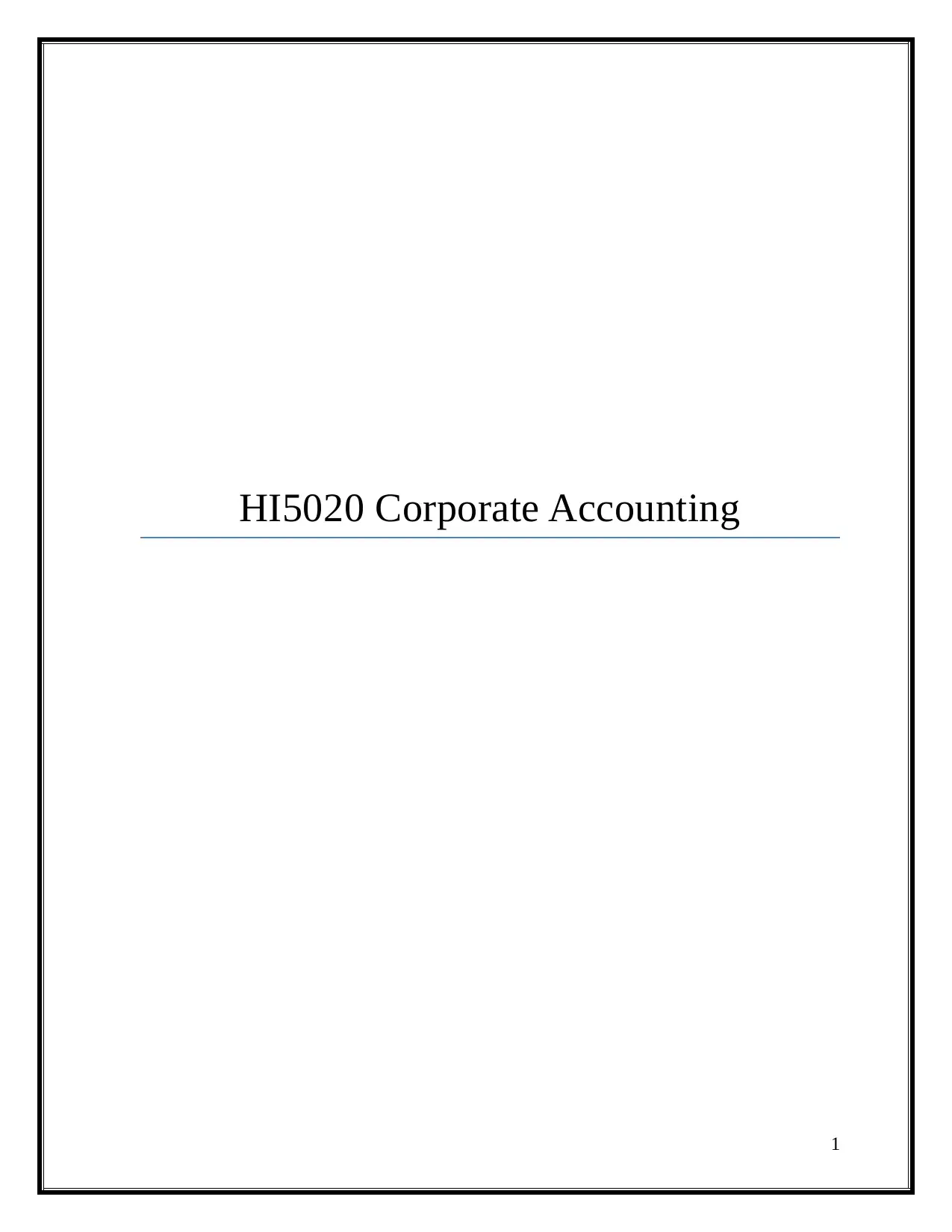
HI5020 Corporate Accounting
1
1
Paraphrase This Document
Need a fresh take? Get an instant paraphrase of this document with our AI Paraphraser
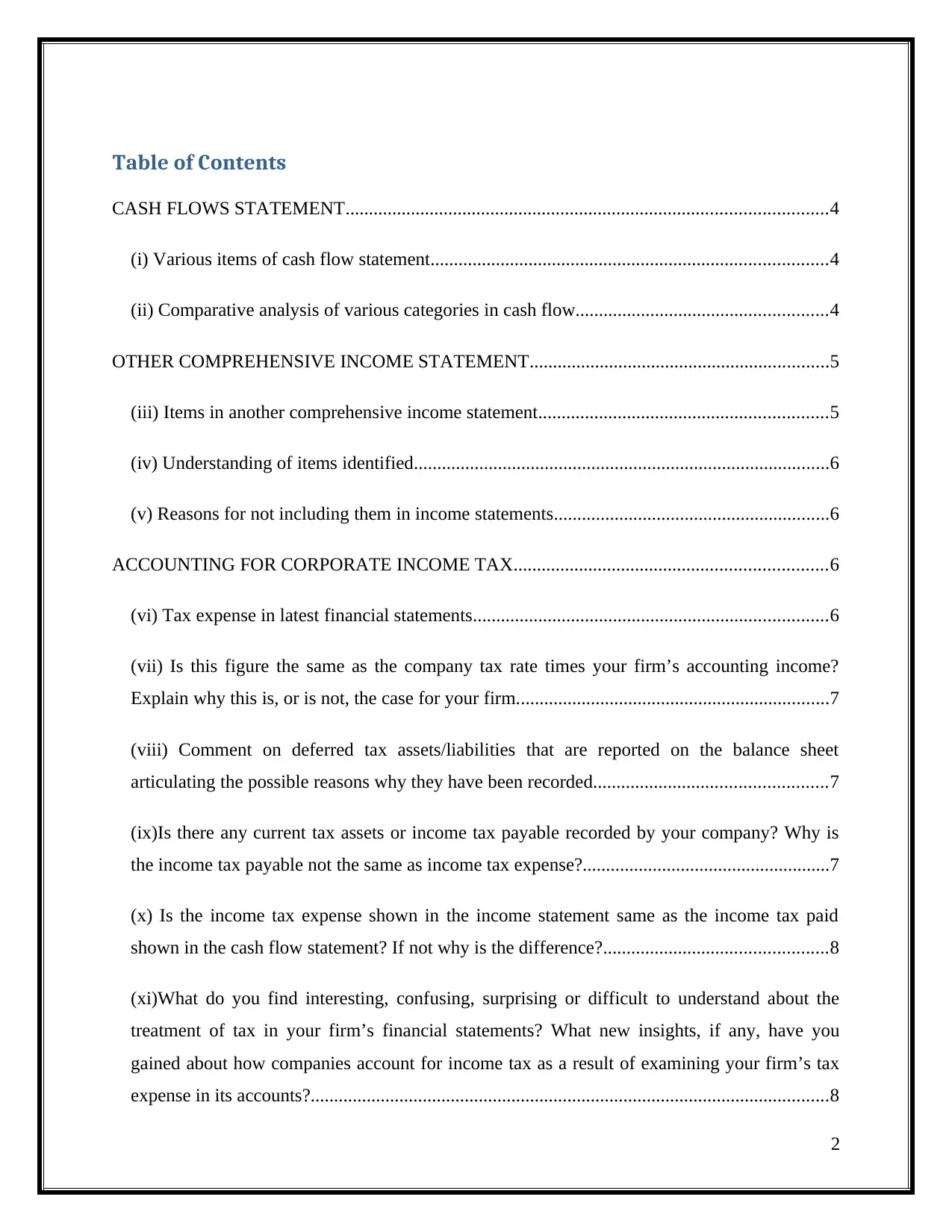
Table of Contents
CASH FLOWS STATEMENT.......................................................................................................4
(i) Various items of cash flow statement.....................................................................................4
(ii) Comparative analysis of various categories in cash flow......................................................4
OTHER COMPREHENSIVE INCOME STATEMENT................................................................5
(iii) Items in another comprehensive income statement..............................................................5
(iv) Understanding of items identified.........................................................................................6
(v) Reasons for not including them in income statements...........................................................6
ACCOUNTING FOR CORPORATE INCOME TAX...................................................................6
(vi) Tax expense in latest financial statements............................................................................6
(vii) Is this figure the same as the company tax rate times your firm’s accounting income?
Explain why this is, or is not, the case for your firm...................................................................7
(viii) Comment on deferred tax assets/liabilities that are reported on the balance sheet
articulating the possible reasons why they have been recorded..................................................7
(ix)Is there any current tax assets or income tax payable recorded by your company? Why is
the income tax payable not the same as income tax expense?.....................................................7
(x) Is the income tax expense shown in the income statement same as the income tax paid
shown in the cash flow statement? If not why is the difference?................................................8
(xi)What do you find interesting, confusing, surprising or difficult to understand about the
treatment of tax in your firm’s financial statements? What new insights, if any, have you
gained about how companies account for income tax as a result of examining your firm’s tax
expense in its accounts?...............................................................................................................8
2
CASH FLOWS STATEMENT.......................................................................................................4
(i) Various items of cash flow statement.....................................................................................4
(ii) Comparative analysis of various categories in cash flow......................................................4
OTHER COMPREHENSIVE INCOME STATEMENT................................................................5
(iii) Items in another comprehensive income statement..............................................................5
(iv) Understanding of items identified.........................................................................................6
(v) Reasons for not including them in income statements...........................................................6
ACCOUNTING FOR CORPORATE INCOME TAX...................................................................6
(vi) Tax expense in latest financial statements............................................................................6
(vii) Is this figure the same as the company tax rate times your firm’s accounting income?
Explain why this is, or is not, the case for your firm...................................................................7
(viii) Comment on deferred tax assets/liabilities that are reported on the balance sheet
articulating the possible reasons why they have been recorded..................................................7
(ix)Is there any current tax assets or income tax payable recorded by your company? Why is
the income tax payable not the same as income tax expense?.....................................................7
(x) Is the income tax expense shown in the income statement same as the income tax paid
shown in the cash flow statement? If not why is the difference?................................................8
(xi)What do you find interesting, confusing, surprising or difficult to understand about the
treatment of tax in your firm’s financial statements? What new insights, if any, have you
gained about how companies account for income tax as a result of examining your firm’s tax
expense in its accounts?...............................................................................................................8
2
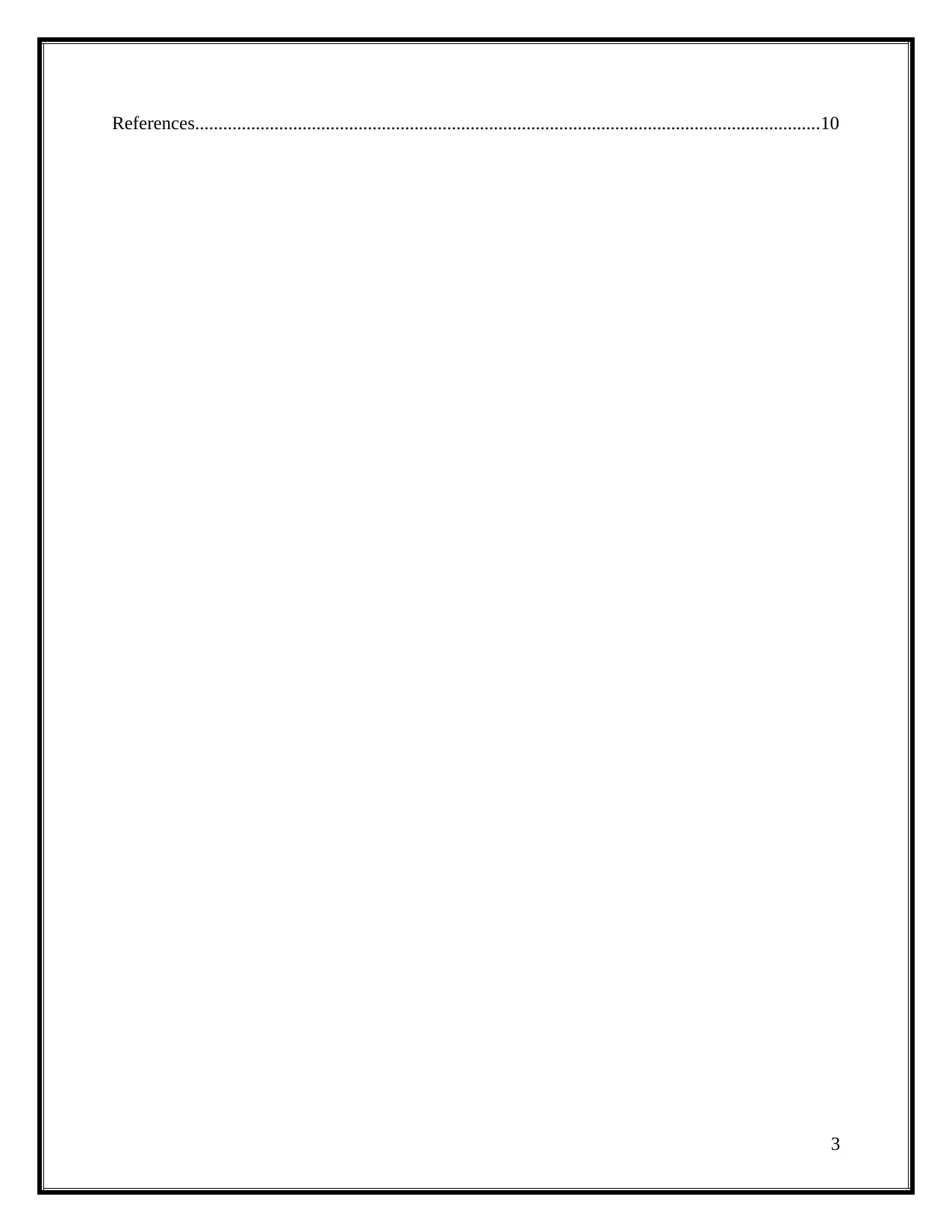
References......................................................................................................................................10
3
3
⊘ This is a preview!⊘
Do you want full access?
Subscribe today to unlock all pages.

Trusted by 1+ million students worldwide
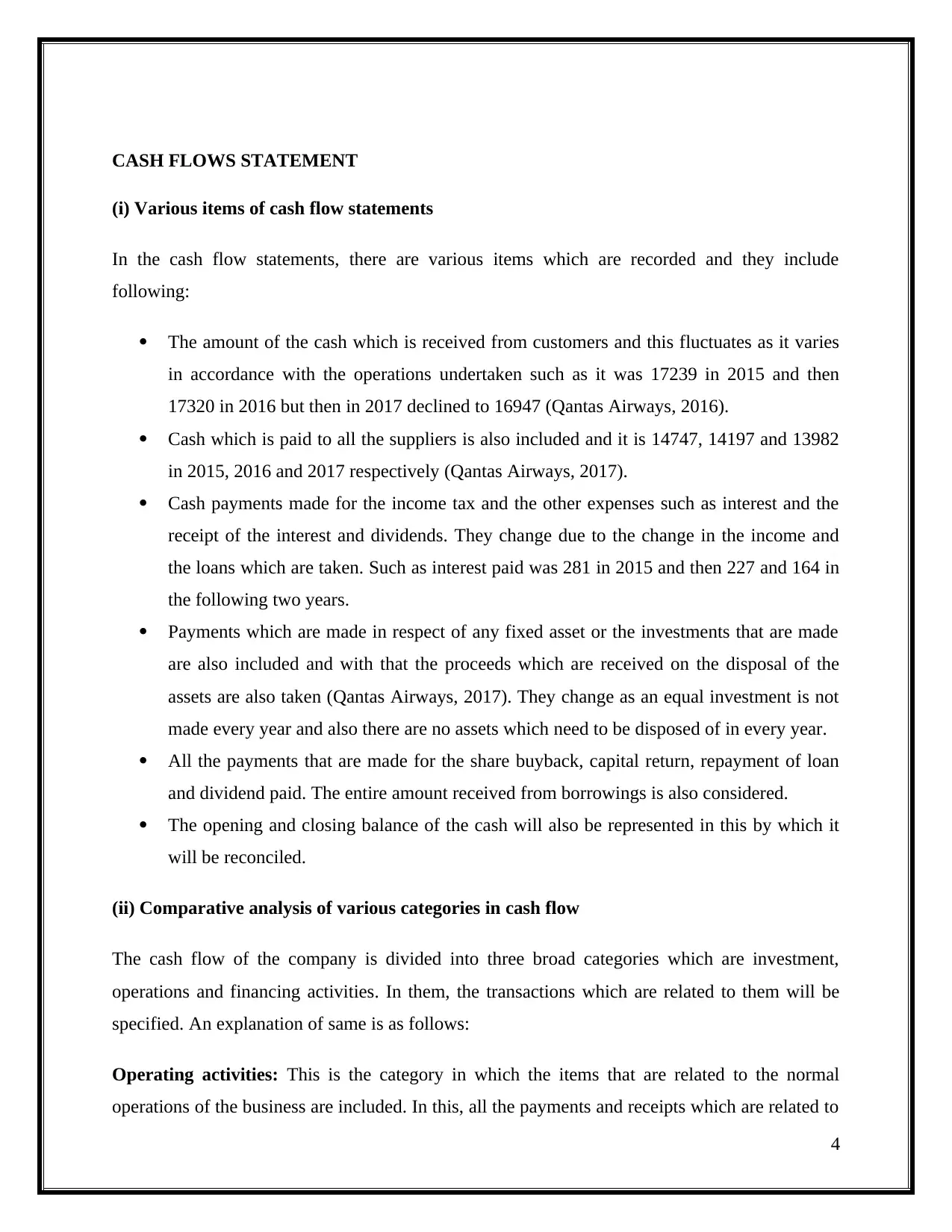
CASH FLOWS STATEMENT
(i) Various items of cash flow statements
In the cash flow statements, there are various items which are recorded and they include
following:
The amount of the cash which is received from customers and this fluctuates as it varies
in accordance with the operations undertaken such as it was 17239 in 2015 and then
17320 in 2016 but then in 2017 declined to 16947 (Qantas Airways, 2016).
Cash which is paid to all the suppliers is also included and it is 14747, 14197 and 13982
in 2015, 2016 and 2017 respectively (Qantas Airways, 2017).
Cash payments made for the income tax and the other expenses such as interest and the
receipt of the interest and dividends. They change due to the change in the income and
the loans which are taken. Such as interest paid was 281 in 2015 and then 227 and 164 in
the following two years.
Payments which are made in respect of any fixed asset or the investments that are made
are also included and with that the proceeds which are received on the disposal of the
assets are also taken (Qantas Airways, 2017). They change as an equal investment is not
made every year and also there are no assets which need to be disposed of in every year.
All the payments that are made for the share buyback, capital return, repayment of loan
and dividend paid. The entire amount received from borrowings is also considered.
The opening and closing balance of the cash will also be represented in this by which it
will be reconciled.
(ii) Comparative analysis of various categories in cash flow
The cash flow of the company is divided into three broad categories which are investment,
operations and financing activities. In them, the transactions which are related to them will be
specified. An explanation of same is as follows:
Operating activities: This is the category in which the items that are related to the normal
operations of the business are included. In this, all the payments and receipts which are related to
4
(i) Various items of cash flow statements
In the cash flow statements, there are various items which are recorded and they include
following:
The amount of the cash which is received from customers and this fluctuates as it varies
in accordance with the operations undertaken such as it was 17239 in 2015 and then
17320 in 2016 but then in 2017 declined to 16947 (Qantas Airways, 2016).
Cash which is paid to all the suppliers is also included and it is 14747, 14197 and 13982
in 2015, 2016 and 2017 respectively (Qantas Airways, 2017).
Cash payments made for the income tax and the other expenses such as interest and the
receipt of the interest and dividends. They change due to the change in the income and
the loans which are taken. Such as interest paid was 281 in 2015 and then 227 and 164 in
the following two years.
Payments which are made in respect of any fixed asset or the investments that are made
are also included and with that the proceeds which are received on the disposal of the
assets are also taken (Qantas Airways, 2017). They change as an equal investment is not
made every year and also there are no assets which need to be disposed of in every year.
All the payments that are made for the share buyback, capital return, repayment of loan
and dividend paid. The entire amount received from borrowings is also considered.
The opening and closing balance of the cash will also be represented in this by which it
will be reconciled.
(ii) Comparative analysis of various categories in cash flow
The cash flow of the company is divided into three broad categories which are investment,
operations and financing activities. In them, the transactions which are related to them will be
specified. An explanation of same is as follows:
Operating activities: This is the category in which the items that are related to the normal
operations of the business are included. In this, all the payments and receipts which are related to
4
Paraphrase This Document
Need a fresh take? Get an instant paraphrase of this document with our AI Paraphraser
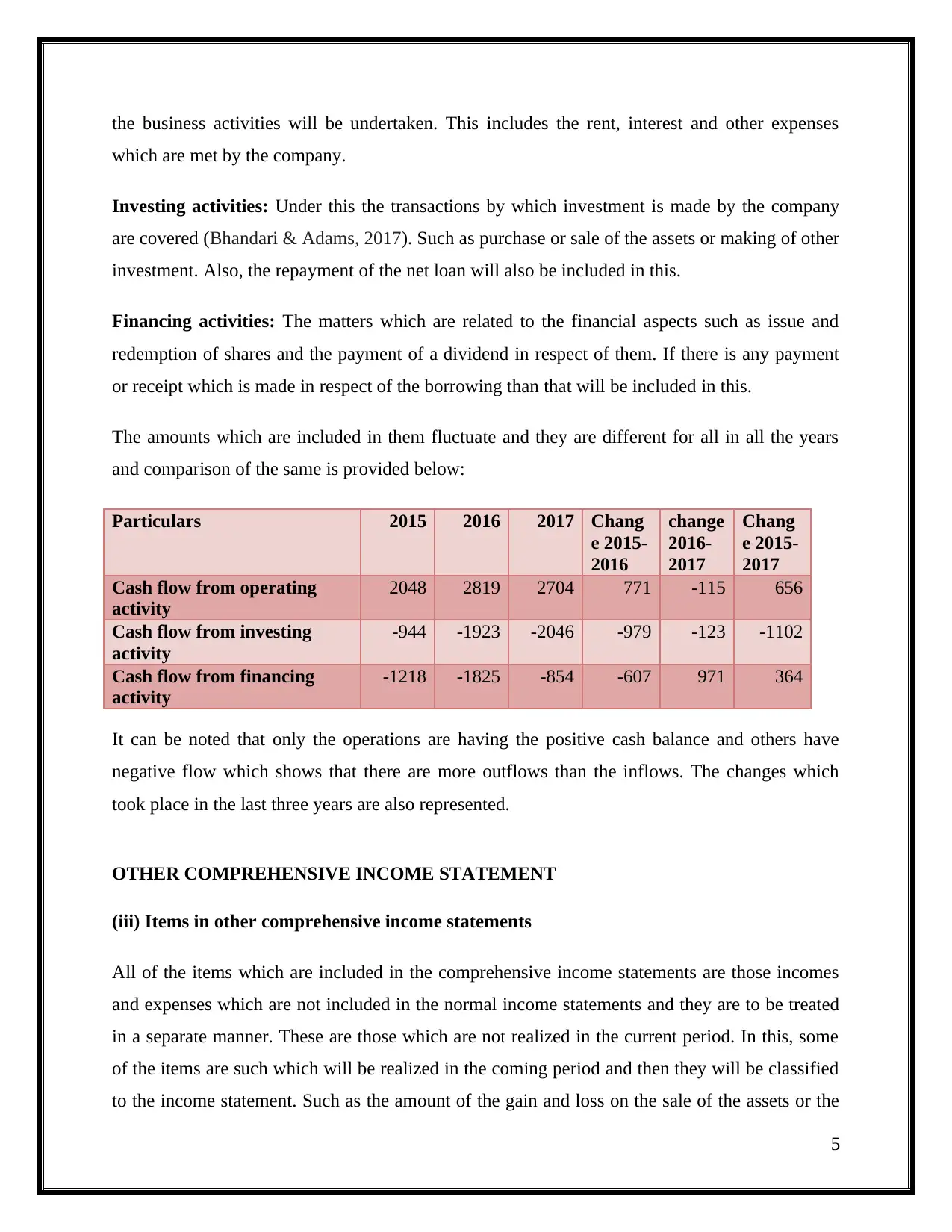
the business activities will be undertaken. This includes the rent, interest and other expenses
which are met by the company.
Investing activities: Under this the transactions by which investment is made by the company
are covered (Bhandari & Adams, 2017). Such as purchase or sale of the assets or making of other
investment. Also, the repayment of the net loan will also be included in this.
Financing activities: The matters which are related to the financial aspects such as issue and
redemption of shares and the payment of a dividend in respect of them. If there is any payment
or receipt which is made in respect of the borrowing than that will be included in this.
The amounts which are included in them fluctuate and they are different for all in all the years
and comparison of the same is provided below:
Particulars 2015 2016 2017 Chang
e 2015-
2016
change
2016-
2017
Chang
e 2015-
2017
Cash flow from operating
activity
2048 2819 2704 771 -115 656
Cash flow from investing
activity
-944 -1923 -2046 -979 -123 -1102
Cash flow from financing
activity
-1218 -1825 -854 -607 971 364
It can be noted that only the operations are having the positive cash balance and others have
negative flow which shows that there are more outflows than the inflows. The changes which
took place in the last three years are also represented.
OTHER COMPREHENSIVE INCOME STATEMENT
(iii) Items in other comprehensive income statements
All of the items which are included in the comprehensive income statements are those incomes
and expenses which are not included in the normal income statements and they are to be treated
in a separate manner. These are those which are not realized in the current period. In this, some
of the items are such which will be realized in the coming period and then they will be classified
to the income statement. Such as the amount of the gain and loss on the sale of the assets or the
5
which are met by the company.
Investing activities: Under this the transactions by which investment is made by the company
are covered (Bhandari & Adams, 2017). Such as purchase or sale of the assets or making of other
investment. Also, the repayment of the net loan will also be included in this.
Financing activities: The matters which are related to the financial aspects such as issue and
redemption of shares and the payment of a dividend in respect of them. If there is any payment
or receipt which is made in respect of the borrowing than that will be included in this.
The amounts which are included in them fluctuate and they are different for all in all the years
and comparison of the same is provided below:
Particulars 2015 2016 2017 Chang
e 2015-
2016
change
2016-
2017
Chang
e 2015-
2017
Cash flow from operating
activity
2048 2819 2704 771 -115 656
Cash flow from investing
activity
-944 -1923 -2046 -979 -123 -1102
Cash flow from financing
activity
-1218 -1825 -854 -607 971 364
It can be noted that only the operations are having the positive cash balance and others have
negative flow which shows that there are more outflows than the inflows. The changes which
took place in the last three years are also represented.
OTHER COMPREHENSIVE INCOME STATEMENT
(iii) Items in other comprehensive income statements
All of the items which are included in the comprehensive income statements are those incomes
and expenses which are not included in the normal income statements and they are to be treated
in a separate manner. These are those which are not realized in the current period. In this, some
of the items are such which will be realized in the coming period and then they will be classified
to the income statement. Such as the amount of the gain and loss on the sale of the assets or the
5
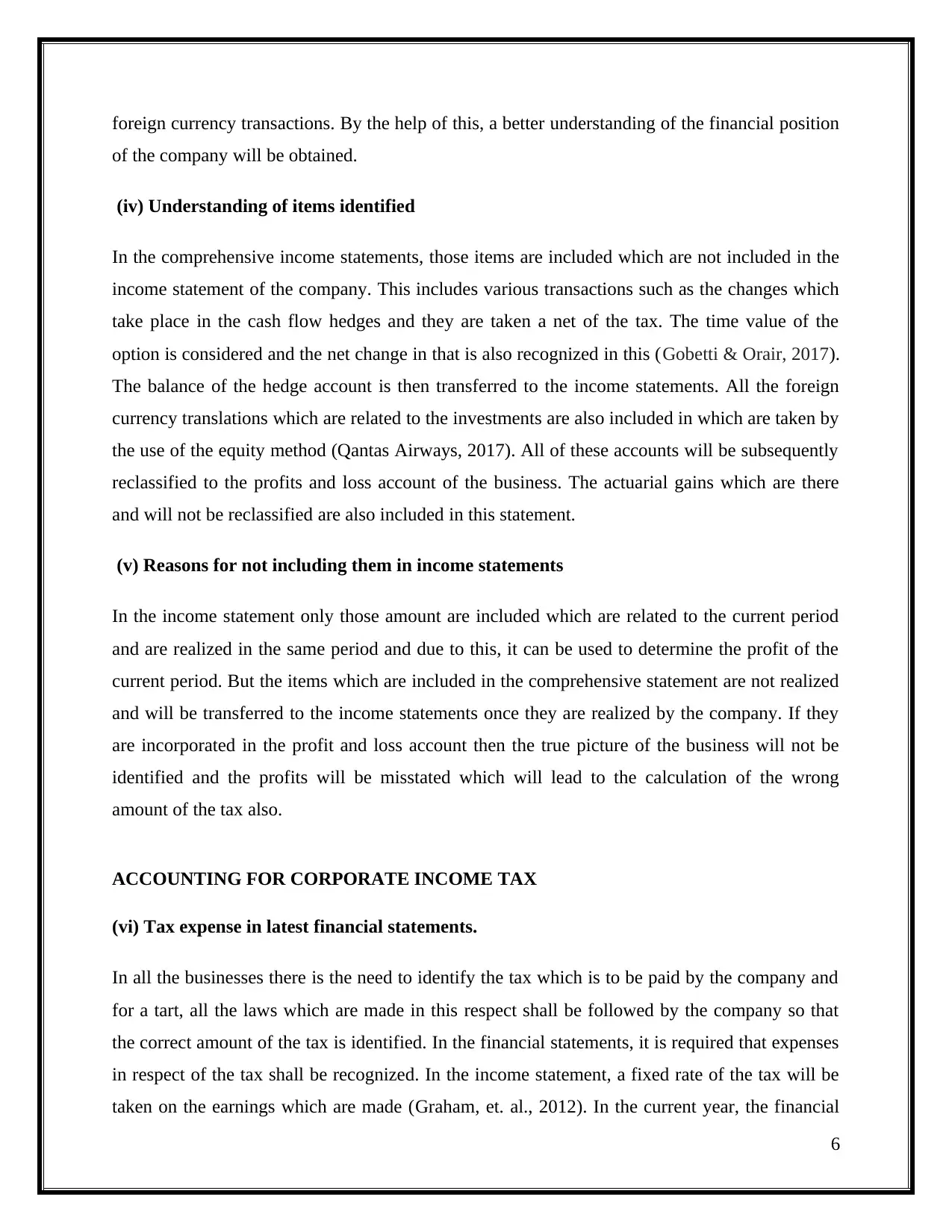
foreign currency transactions. By the help of this, a better understanding of the financial position
of the company will be obtained.
(iv) Understanding of items identified
In the comprehensive income statements, those items are included which are not included in the
income statement of the company. This includes various transactions such as the changes which
take place in the cash flow hedges and they are taken a net of the tax. The time value of the
option is considered and the net change in that is also recognized in this (Gobetti & Orair, 2017).
The balance of the hedge account is then transferred to the income statements. All the foreign
currency translations which are related to the investments are also included in which are taken by
the use of the equity method (Qantas Airways, 2017). All of these accounts will be subsequently
reclassified to the profits and loss account of the business. The actuarial gains which are there
and will not be reclassified are also included in this statement.
(v) Reasons for not including them in income statements
In the income statement only those amount are included which are related to the current period
and are realized in the same period and due to this, it can be used to determine the profit of the
current period. But the items which are included in the comprehensive statement are not realized
and will be transferred to the income statements once they are realized by the company. If they
are incorporated in the profit and loss account then the true picture of the business will not be
identified and the profits will be misstated which will lead to the calculation of the wrong
amount of the tax also.
ACCOUNTING FOR CORPORATE INCOME TAX
(vi) Tax expense in latest financial statements.
In all the businesses there is the need to identify the tax which is to be paid by the company and
for a tart, all the laws which are made in this respect shall be followed by the company so that
the correct amount of the tax is identified. In the financial statements, it is required that expenses
in respect of the tax shall be recognized. In the income statement, a fixed rate of the tax will be
taken on the earnings which are made (Graham, et. al., 2012). In the current year, the financial
6
of the company will be obtained.
(iv) Understanding of items identified
In the comprehensive income statements, those items are included which are not included in the
income statement of the company. This includes various transactions such as the changes which
take place in the cash flow hedges and they are taken a net of the tax. The time value of the
option is considered and the net change in that is also recognized in this (Gobetti & Orair, 2017).
The balance of the hedge account is then transferred to the income statements. All the foreign
currency translations which are related to the investments are also included in which are taken by
the use of the equity method (Qantas Airways, 2017). All of these accounts will be subsequently
reclassified to the profits and loss account of the business. The actuarial gains which are there
and will not be reclassified are also included in this statement.
(v) Reasons for not including them in income statements
In the income statement only those amount are included which are related to the current period
and are realized in the same period and due to this, it can be used to determine the profit of the
current period. But the items which are included in the comprehensive statement are not realized
and will be transferred to the income statements once they are realized by the company. If they
are incorporated in the profit and loss account then the true picture of the business will not be
identified and the profits will be misstated which will lead to the calculation of the wrong
amount of the tax also.
ACCOUNTING FOR CORPORATE INCOME TAX
(vi) Tax expense in latest financial statements.
In all the businesses there is the need to identify the tax which is to be paid by the company and
for a tart, all the laws which are made in this respect shall be followed by the company so that
the correct amount of the tax is identified. In the financial statements, it is required that expenses
in respect of the tax shall be recognized. In the income statement, a fixed rate of the tax will be
taken on the earnings which are made (Graham, et. al., 2012). In the current year, the financial
6
⊘ This is a preview!⊘
Do you want full access?
Subscribe today to unlock all pages.

Trusted by 1+ million students worldwide
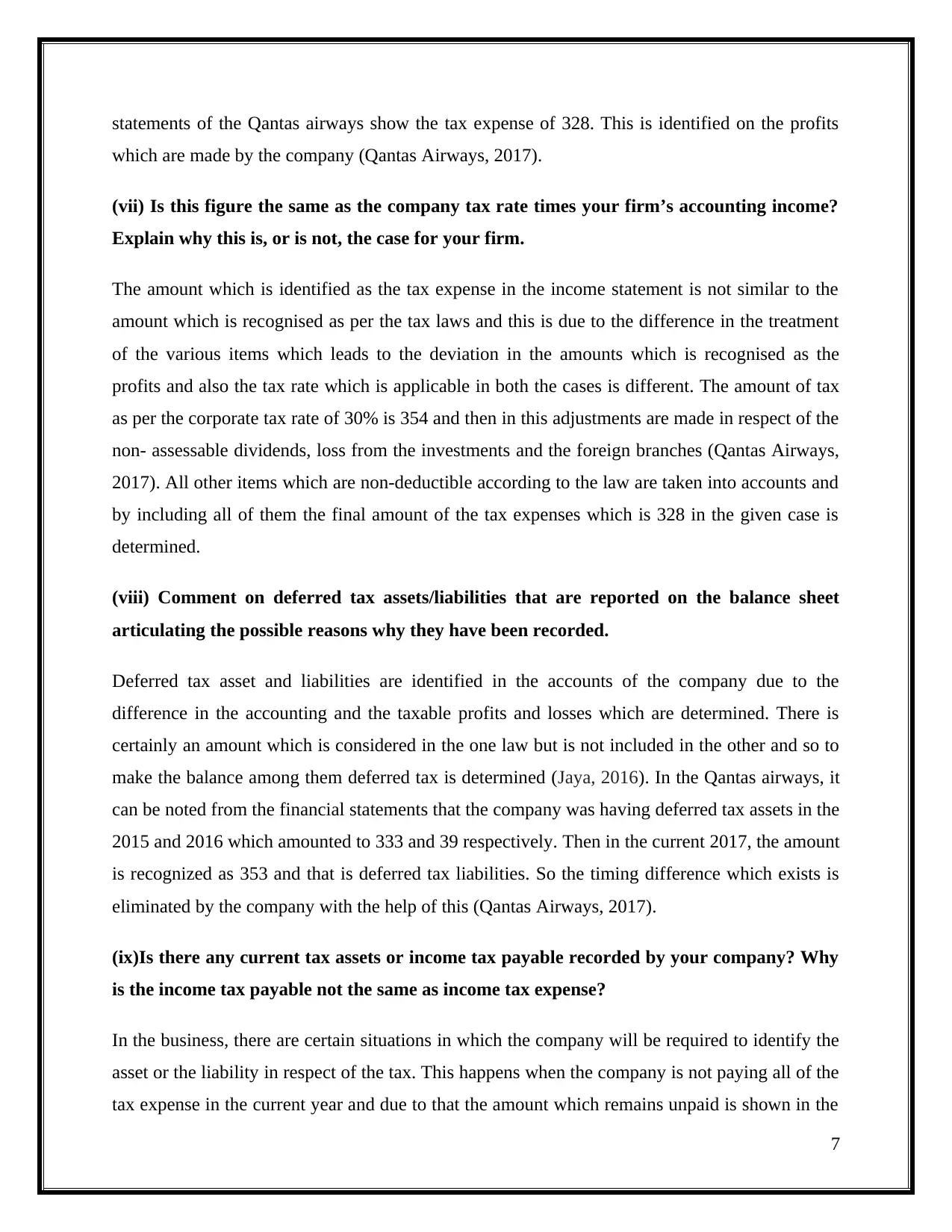
statements of the Qantas airways show the tax expense of 328. This is identified on the profits
which are made by the company (Qantas Airways, 2017).
(vii) Is this figure the same as the company tax rate times your firm’s accounting income?
Explain why this is, or is not, the case for your firm.
The amount which is identified as the tax expense in the income statement is not similar to the
amount which is recognised as per the tax laws and this is due to the difference in the treatment
of the various items which leads to the deviation in the amounts which is recognised as the
profits and also the tax rate which is applicable in both the cases is different. The amount of tax
as per the corporate tax rate of 30% is 354 and then in this adjustments are made in respect of the
non- assessable dividends, loss from the investments and the foreign branches (Qantas Airways,
2017). All other items which are non-deductible according to the law are taken into accounts and
by including all of them the final amount of the tax expenses which is 328 in the given case is
determined.
(viii) Comment on deferred tax assets/liabilities that are reported on the balance sheet
articulating the possible reasons why they have been recorded.
Deferred tax asset and liabilities are identified in the accounts of the company due to the
difference in the accounting and the taxable profits and losses which are determined. There is
certainly an amount which is considered in the one law but is not included in the other and so to
make the balance among them deferred tax is determined (Jaya, 2016). In the Qantas airways, it
can be noted from the financial statements that the company was having deferred tax assets in the
2015 and 2016 which amounted to 333 and 39 respectively. Then in the current 2017, the amount
is recognized as 353 and that is deferred tax liabilities. So the timing difference which exists is
eliminated by the company with the help of this (Qantas Airways, 2017).
(ix)Is there any current tax assets or income tax payable recorded by your company? Why
is the income tax payable not the same as income tax expense?
In the business, there are certain situations in which the company will be required to identify the
asset or the liability in respect of the tax. This happens when the company is not paying all of the
tax expense in the current year and due to that the amount which remains unpaid is shown in the
7
which are made by the company (Qantas Airways, 2017).
(vii) Is this figure the same as the company tax rate times your firm’s accounting income?
Explain why this is, or is not, the case for your firm.
The amount which is identified as the tax expense in the income statement is not similar to the
amount which is recognised as per the tax laws and this is due to the difference in the treatment
of the various items which leads to the deviation in the amounts which is recognised as the
profits and also the tax rate which is applicable in both the cases is different. The amount of tax
as per the corporate tax rate of 30% is 354 and then in this adjustments are made in respect of the
non- assessable dividends, loss from the investments and the foreign branches (Qantas Airways,
2017). All other items which are non-deductible according to the law are taken into accounts and
by including all of them the final amount of the tax expenses which is 328 in the given case is
determined.
(viii) Comment on deferred tax assets/liabilities that are reported on the balance sheet
articulating the possible reasons why they have been recorded.
Deferred tax asset and liabilities are identified in the accounts of the company due to the
difference in the accounting and the taxable profits and losses which are determined. There is
certainly an amount which is considered in the one law but is not included in the other and so to
make the balance among them deferred tax is determined (Jaya, 2016). In the Qantas airways, it
can be noted from the financial statements that the company was having deferred tax assets in the
2015 and 2016 which amounted to 333 and 39 respectively. Then in the current 2017, the amount
is recognized as 353 and that is deferred tax liabilities. So the timing difference which exists is
eliminated by the company with the help of this (Qantas Airways, 2017).
(ix)Is there any current tax assets or income tax payable recorded by your company? Why
is the income tax payable not the same as income tax expense?
In the business, there are certain situations in which the company will be required to identify the
asset or the liability in respect of the tax. This happens when the company is not paying all of the
tax expense in the current year and due to that the amount which remains unpaid is shown in the
7
Paraphrase This Document
Need a fresh take? Get an instant paraphrase of this document with our AI Paraphraser
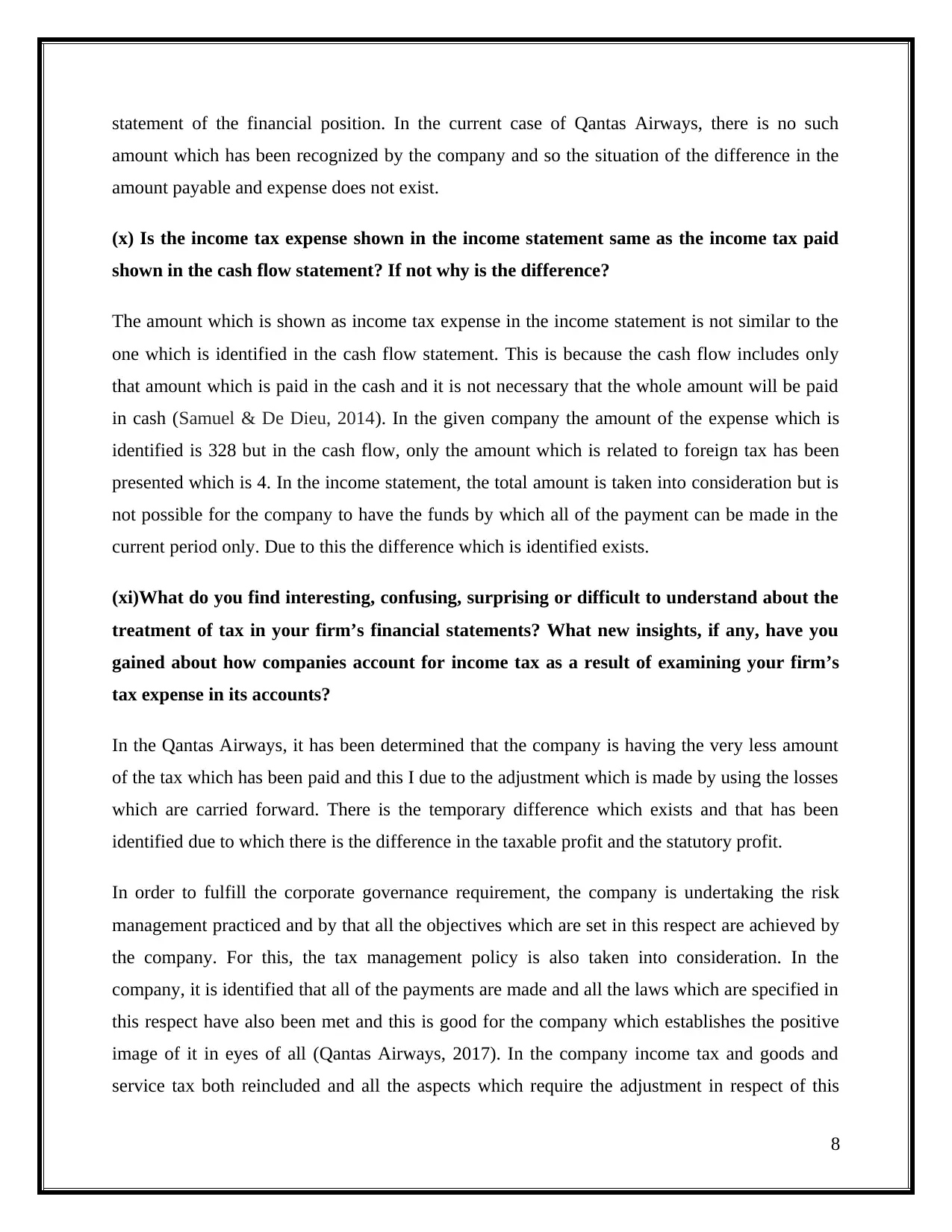
statement of the financial position. In the current case of Qantas Airways, there is no such
amount which has been recognized by the company and so the situation of the difference in the
amount payable and expense does not exist.
(x) Is the income tax expense shown in the income statement same as the income tax paid
shown in the cash flow statement? If not why is the difference?
The amount which is shown as income tax expense in the income statement is not similar to the
one which is identified in the cash flow statement. This is because the cash flow includes only
that amount which is paid in the cash and it is not necessary that the whole amount will be paid
in cash (Samuel & De Dieu, 2014). In the given company the amount of the expense which is
identified is 328 but in the cash flow, only the amount which is related to foreign tax has been
presented which is 4. In the income statement, the total amount is taken into consideration but is
not possible for the company to have the funds by which all of the payment can be made in the
current period only. Due to this the difference which is identified exists.
(xi)What do you find interesting, confusing, surprising or difficult to understand about the
treatment of tax in your firm’s financial statements? What new insights, if any, have you
gained about how companies account for income tax as a result of examining your firm’s
tax expense in its accounts?
In the Qantas Airways, it has been determined that the company is having the very less amount
of the tax which has been paid and this I due to the adjustment which is made by using the losses
which are carried forward. There is the temporary difference which exists and that has been
identified due to which there is the difference in the taxable profit and the statutory profit.
In order to fulfill the corporate governance requirement, the company is undertaking the risk
management practiced and by that all the objectives which are set in this respect are achieved by
the company. For this, the tax management policy is also taken into consideration. In the
company, it is identified that all of the payments are made and all the laws which are specified in
this respect have also been met and this is good for the company which establishes the positive
image of it in eyes of all (Qantas Airways, 2017). In the company income tax and goods and
service tax both reincluded and all the aspects which require the adjustment in respect of this
8
amount which has been recognized by the company and so the situation of the difference in the
amount payable and expense does not exist.
(x) Is the income tax expense shown in the income statement same as the income tax paid
shown in the cash flow statement? If not why is the difference?
The amount which is shown as income tax expense in the income statement is not similar to the
one which is identified in the cash flow statement. This is because the cash flow includes only
that amount which is paid in the cash and it is not necessary that the whole amount will be paid
in cash (Samuel & De Dieu, 2014). In the given company the amount of the expense which is
identified is 328 but in the cash flow, only the amount which is related to foreign tax has been
presented which is 4. In the income statement, the total amount is taken into consideration but is
not possible for the company to have the funds by which all of the payment can be made in the
current period only. Due to this the difference which is identified exists.
(xi)What do you find interesting, confusing, surprising or difficult to understand about the
treatment of tax in your firm’s financial statements? What new insights, if any, have you
gained about how companies account for income tax as a result of examining your firm’s
tax expense in its accounts?
In the Qantas Airways, it has been determined that the company is having the very less amount
of the tax which has been paid and this I due to the adjustment which is made by using the losses
which are carried forward. There is the temporary difference which exists and that has been
identified due to which there is the difference in the taxable profit and the statutory profit.
In order to fulfill the corporate governance requirement, the company is undertaking the risk
management practiced and by that all the objectives which are set in this respect are achieved by
the company. For this, the tax management policy is also taken into consideration. In the
company, it is identified that all of the payments are made and all the laws which are specified in
this respect have also been met and this is good for the company which establishes the positive
image of it in eyes of all (Qantas Airways, 2017). In the company income tax and goods and
service tax both reincluded and all the aspects which require the adjustment in respect of this
8
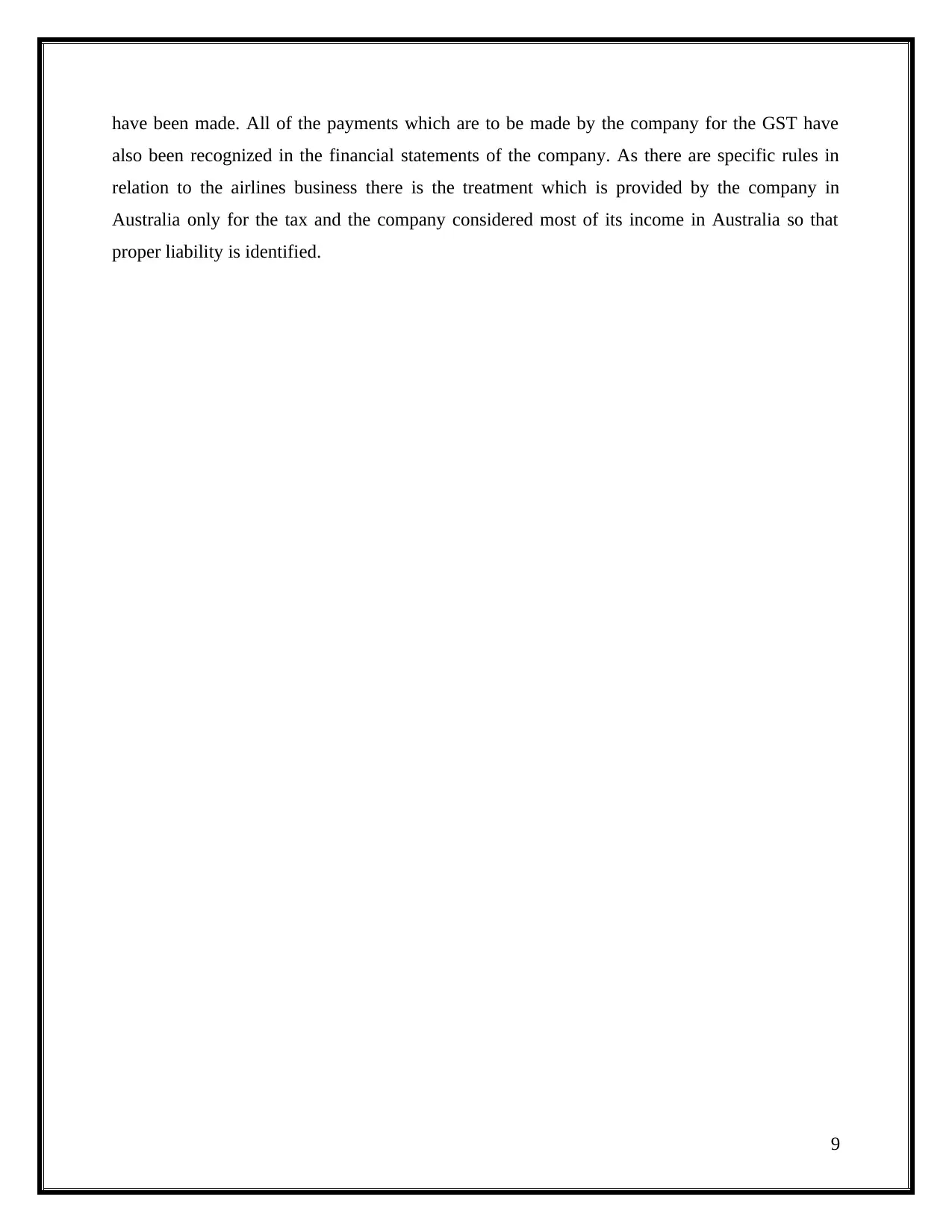
have been made. All of the payments which are to be made by the company for the GST have
also been recognized in the financial statements of the company. As there are specific rules in
relation to the airlines business there is the treatment which is provided by the company in
Australia only for the tax and the company considered most of its income in Australia so that
proper liability is identified.
9
also been recognized in the financial statements of the company. As there are specific rules in
relation to the airlines business there is the treatment which is provided by the company in
Australia only for the tax and the company considered most of its income in Australia so that
proper liability is identified.
9
⊘ This is a preview!⊘
Do you want full access?
Subscribe today to unlock all pages.

Trusted by 1+ million students worldwide
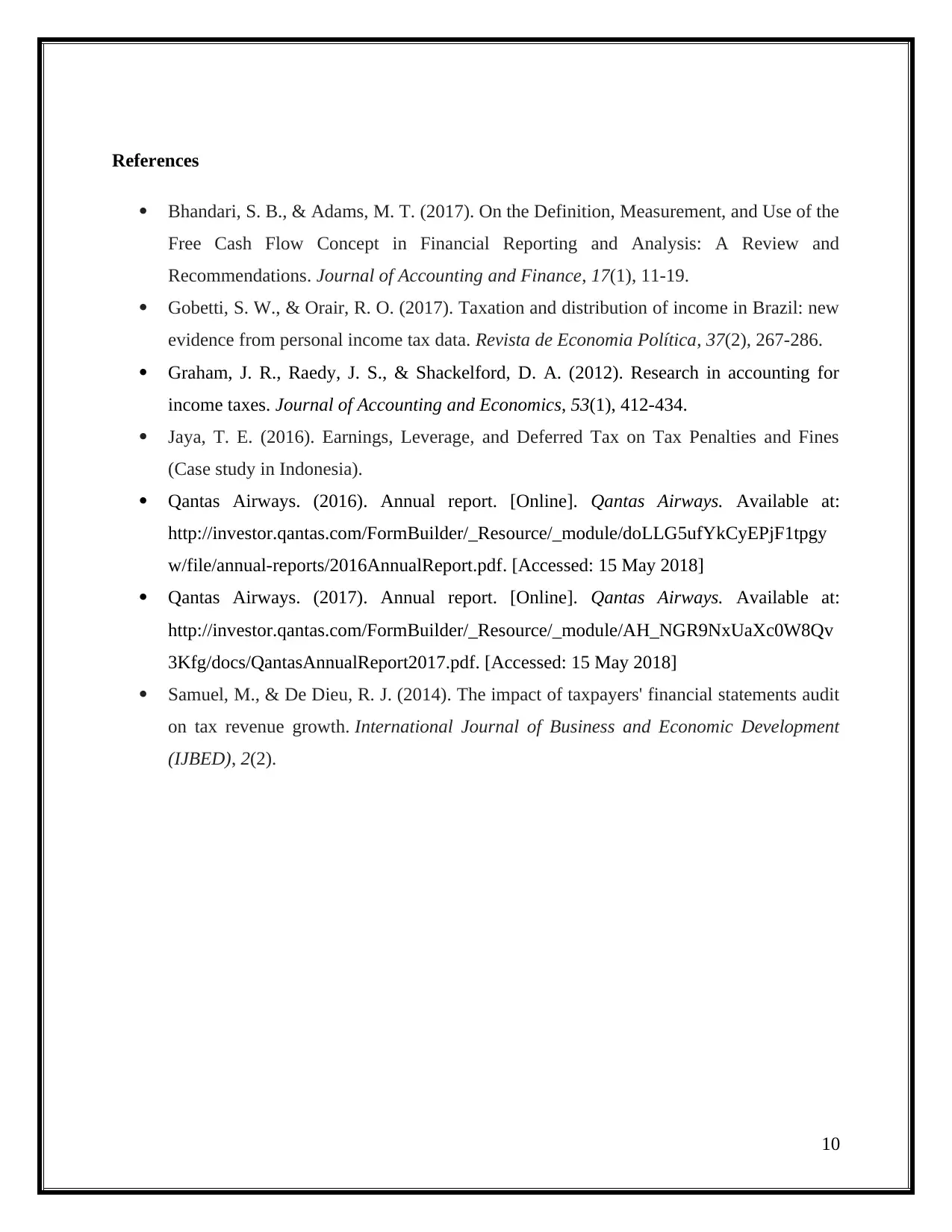
References
Bhandari, S. B., & Adams, M. T. (2017). On the Definition, Measurement, and Use of the
Free Cash Flow Concept in Financial Reporting and Analysis: A Review and
Recommendations. Journal of Accounting and Finance, 17(1), 11-19.
Gobetti, S. W., & Orair, R. O. (2017). Taxation and distribution of income in Brazil: new
evidence from personal income tax data. Revista de Economia Política, 37(2), 267-286.
Graham, J. R., Raedy, J. S., & Shackelford, D. A. (2012). Research in accounting for
income taxes. Journal of Accounting and Economics, 53(1), 412-434.
Jaya, T. E. (2016). Earnings, Leverage, and Deferred Tax on Tax Penalties and Fines
(Case study in Indonesia).
Qantas Airways. (2016). Annual report. [Online]. Qantas Airways. Available at:
http://investor.qantas.com/FormBuilder/_Resource/_module/doLLG5ufYkCyEPjF1tpgy
w/file/annual-reports/2016AnnualReport.pdf. [Accessed: 15 May 2018]
Qantas Airways. (2017). Annual report. [Online]. Qantas Airways. Available at:
http://investor.qantas.com/FormBuilder/_Resource/_module/AH_NGR9NxUaXc0W8Qv
3Kfg/docs/QantasAnnualReport2017.pdf. [Accessed: 15 May 2018]
Samuel, M., & De Dieu, R. J. (2014). The impact of taxpayers' financial statements audit
on tax revenue growth. International Journal of Business and Economic Development
(IJBED), 2(2).
10
Bhandari, S. B., & Adams, M. T. (2017). On the Definition, Measurement, and Use of the
Free Cash Flow Concept in Financial Reporting and Analysis: A Review and
Recommendations. Journal of Accounting and Finance, 17(1), 11-19.
Gobetti, S. W., & Orair, R. O. (2017). Taxation and distribution of income in Brazil: new
evidence from personal income tax data. Revista de Economia Política, 37(2), 267-286.
Graham, J. R., Raedy, J. S., & Shackelford, D. A. (2012). Research in accounting for
income taxes. Journal of Accounting and Economics, 53(1), 412-434.
Jaya, T. E. (2016). Earnings, Leverage, and Deferred Tax on Tax Penalties and Fines
(Case study in Indonesia).
Qantas Airways. (2016). Annual report. [Online]. Qantas Airways. Available at:
http://investor.qantas.com/FormBuilder/_Resource/_module/doLLG5ufYkCyEPjF1tpgy
w/file/annual-reports/2016AnnualReport.pdf. [Accessed: 15 May 2018]
Qantas Airways. (2017). Annual report. [Online]. Qantas Airways. Available at:
http://investor.qantas.com/FormBuilder/_Resource/_module/AH_NGR9NxUaXc0W8Qv
3Kfg/docs/QantasAnnualReport2017.pdf. [Accessed: 15 May 2018]
Samuel, M., & De Dieu, R. J. (2014). The impact of taxpayers' financial statements audit
on tax revenue growth. International Journal of Business and Economic Development
(IJBED), 2(2).
10
1 out of 10
Related Documents
Your All-in-One AI-Powered Toolkit for Academic Success.
+13062052269
info@desklib.com
Available 24*7 on WhatsApp / Email
![[object Object]](/_next/static/media/star-bottom.7253800d.svg)
Unlock your academic potential
Copyright © 2020–2025 A2Z Services. All Rights Reserved. Developed and managed by ZUCOL.




